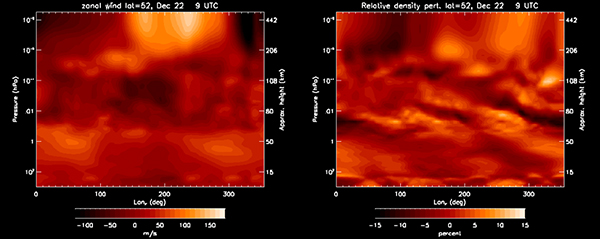Hurricanes that may reach to the edge of space
Sep 16, 2010 - by Staff
Sep 16, 2010 - by Staff
David Hosansky | 16 September 2010 • Can a distant hurricane play havoc with your GPS unit? Scientists aren’t sure of the answer, but they suspect that hurricanes affect more than land and water. They’re looking high up in the atmosphere to see if these giant storms also unsettle the ionosphere. Given that the ionosphere is comprised of electrically charged atoms and molecules, whose behavior is critical for the smooth workings of Global Positioning System signals and communications systems, this isn’t just an esoteric matter. It’s of particular interest to certain users, such as the U.S. Navy, which would like to better predict GPS disruptions.
But how to tease out the impacts of a hurricane on a remote slice of the atmosphere that sits at the edge of space? Much of the influence on the ionosphere comes from the Sun, which can mask any impacts from the lower atmosphere. And if a hurricane does affect the outer atmosphere, its impact may not be felt in the region of the ionosphere that sits above the storm. The ionosphere is configured along geomagnetic lines in such a way that the impact of a storm may be felt on the other side of the planet.
“I think that hurricanes and other major storms can definitely contribute to upper atmospheric variability,” says Hanli Liu, a scientist at NCAR’s High Altitude Observatory. “It is, however, difficult to clearly identify their impacts.”
Years ago, scientists believed that the outer atmosphere was almost exclusively influenced by the Sun. But they now believe that major storms can cause impacts that reverberate high above Earth’s surface.
The process may work like this:
Such an event, known as an ionospheric bubble or spread-F, can affect the accuracy of GPS signals and disrupt communications networks that we rely on. (The AMS meteorology glossary explains spread-F on this page.)
These ionospheric bubbles are somewhat analogous to the better-known geomagnetic storms that are triggered by massive eruptions of charged particles from the Sun. The bubbles, however, differ in several key respects:
Liu is not directly studying the impacts of hurricanes on the ionosphere. But he’s working with colleagues around NCAR as well as NOAA, the Navel Research Laboratory, and the University of Colorado at Boulder on computer modeling that may shed light on the problem. They’re adding a program that simulates ionospheric electrodynamics to a computer model, known as WACCM, that simulates the entire atmosphere. This will enable researchers to study how events in the lower atmosphere move upward and unsettle the ionosphere. The new approach will also reveal ionospheric bubbles and other events that are as small as about 30 miles across. This is a big advance over current computer modeling that only can capture events 150 miles across or larger.

These animations, from newly developed model software known as WACCM-X, show simulations of wind and density in the outer atmosphere. Click here or on the image to launch the animation. (Animations by Hanli Liu, NCAR.)
Liu believes that such detailed computer simulations are about two years away. If all goes well, scientists will be able to track events in the atmosphere from just above Earth’s surface all the way to the upper ionosphere, more than 300 miles high. And, in addition to simulating these processes on supercomputers, they will also be able to use the new computer modeling to help with more precise measurements with instruments that measure processes in the outer atmosphere.
“No one really knows the answer yet about storms and the ionosphere,” Liu says. “But we are hoping to make progress on this question with a combination of observational, statistical, and numerical methods.”